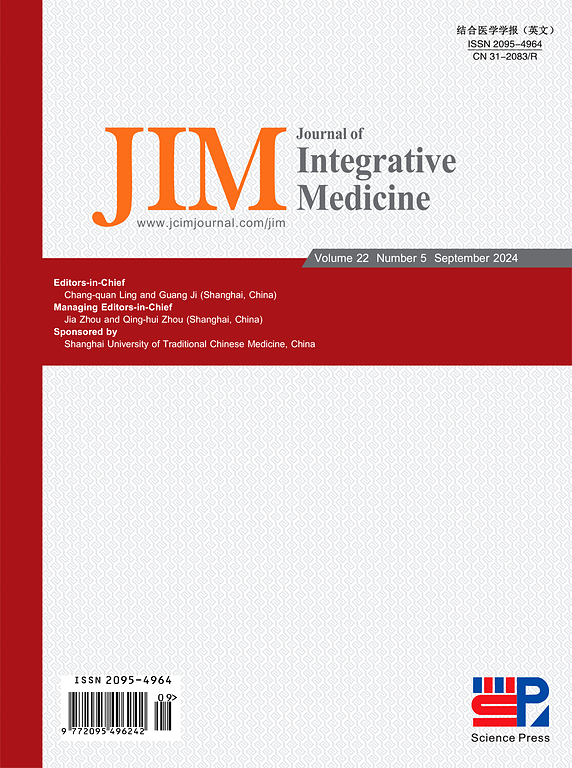Strychni Semen and its active compounds promote axon regeneration following peripheral nerve injury by suppressing myeloperoxidase in the dorsal root ganglia
IF 4
2区 医学
Q1 INTEGRATIVE & COMPLEMENTARY MEDICINE
引用次数: 0
Abstract
Objective
Treating peripheral nerve injury (PNI) presents a clinical challenge due to limited axon regeneration. Strychni Semen, a traditional Chinese medicine, is clinically used for numbness and hemiplegia. However, its role in promoting functional recovery after PNI and the related mechanisms have not yet been systematically studied.
Methods
A mouse model of sciatic nerve crush (SNC) injury was established and the mice received drug treatment via intragastric gavage, followed by behavioral assessments (adhesive removal test, hot-plate test and Von Frey test). Transcriptomic analyses were performed to examine gene expression in the dorsal root ganglia (DRGs) from the third to the sixth lumbar vertebrae, so as to identify the significantly differentially expressed genes. Immunofluorescence staining was used to assess the expression levels of superior cervical ganglia neural-specific 10 protein (SCG10). The ultra-trace protein detection technique was used to evaluate changes in gene expression levels.
Results
Strychni Semen and its active compounds (brucine and strychnine) improved functional recovery in mice following SNC injury. Transcriptomic data indicated that Strychni Semen and its active compounds initiated transcriptional reprogramming that impacted cellular morphology and extracellular matrix remodeling in DRGs after SNC, suggesting potential roles in promoting axon regeneration. Imaging data further confirmed that Strychni Semen and its active compounds facilitated axon regrowth in SNC-injured mice. By integrating protein–protein interaction predictions, ultra-trace protein detection, and molecular docking analysis, we identified myeloperoxidase as a potentially critical factor in the axon regenerative effects conferred by Strychni Semen and its active compounds.
Conclusion
Strychni Semen and its active compounds enhance sensory function by promoting axonal regeneration after PNI. These findings establish a foundation for the future applications of Strychni Semen and highlight novel therapeutic strategies and drug targets for axon regeneration.
Please cite this article as: Zhang Y, Zhao XY, Liu MT, Zhou ZC, Cheng HB, Jiang XH, Zheng YR, Chen Z. Strychni Semen and its active compounds promote axon regeneration following peripheral nerve injury by suppressing myeloperoxidase in the dorsal root ganglia. J Integr Med. 2025; 23(2): 169–181.
马钱子及其活性成分通过抑制背根神经节髓过氧化物酶促进周围神经损伤后轴突再生。
目的:由于轴突再生有限,周围神经损伤(PNI)的治疗面临着临床挑战。马钱子是一种中药,临床上用于治疗麻木和偏瘫。然而,其在促进PNI后功能恢复中的作用及其机制尚未得到系统研究。方法:建立小鼠坐骨神经压迫(SNC)损伤模型,给予小鼠灌胃药物治疗,并进行行为学评价(除粘试验、热板试验、Von Frey试验)。通过转录组学分析,检测第3 ~第6腰椎背根神经节(DRGs)的基因表达,以鉴定显著差异表达的基因。免疫荧光染色检测颈上神经节神经特异性10蛋白(SCG10)的表达水平。采用超微量蛋白检测技术评价基因表达水平的变化。结果:马钱子及其活性成分马钱子碱和马钱子碱能促进小鼠SNC损伤后的功能恢复。转录组学数据表明,马钱子及其活性化合物启动转录重编程,影响SNC后DRGs的细胞形态和细胞外基质重塑,提示其可能促进轴突再生。成像数据进一步证实马钱子及其活性化合物促进snc损伤小鼠轴突再生。通过整合蛋白-蛋白相互作用预测、超痕量蛋白检测和分子对接分析,我们确定髓过氧化物酶是马钱子及其活性化合物赋予轴突再生作用的潜在关键因素。结论:马钱子及其活性成分通过促进PNI后轴突再生来增强感觉功能。这些发现为马钱子的未来应用奠定了基础,并为轴突再生提供了新的治疗策略和药物靶点。张勇,赵小燕,刘明明,周志成,程宏斌,蒋晓华,郑玉华,陈忠。马钱子及其活性成分通过抑制背根神经节髓过氧化物酶促进周围神经损伤后轴突再生。集成医学[J];打印前Epub。
本文章由计算机程序翻译,如有差异,请以英文原文为准。
求助全文
约1分钟内获得全文
求助全文
来源期刊

Journal of Integrative Medicine-Jim
Medicine-Complementary and Alternative Medicine
CiteScore
9.20
自引率
4.20%
发文量
3319
期刊介绍:
The predecessor of JIM is the Journal of Chinese Integrative Medicine (Zhong Xi Yi Jie He Xue Bao). With this new, English-language publication, we are committed to make JIM an international platform for publishing high-quality papers on complementary and alternative medicine (CAM) and an open forum in which the different professions and international scholarly communities can exchange views, share research and their clinical experience, discuss CAM education, and confer about issues and problems in our various disciplines and in CAM as a whole in order to promote integrative medicine.
JIM is indexed/abstracted in: MEDLINE/PubMed, ScienceDirect, Emerging Sources Citation Index (ESCI), Scopus, Embase, Chemical Abstracts (CA), CAB Abstracts, EBSCO, WPRIM, JST China, Chinese Science Citation Database (CSCD), and China National Knowledge Infrastructure (CNKI).
JIM Editorial Office uses ThomsonReuters ScholarOne Manuscripts as submitting and review system (submission link: http://mc03.manuscriptcentral.com/jcim-en).
JIM is published bimonthly. Manuscripts submitted to JIM should be written in English. Article types include but are not limited to randomized controlled and pragmatic trials, translational and patient-centered effectiveness outcome studies, case series and reports, clinical trial protocols, preclinical and basic science studies, systematic reviews and meta-analyses, papers on methodology and CAM history or education, conference proceedings, editorials, commentaries, short communications, book reviews, and letters to the editor.
Our purpose is to publish a prestigious international journal for studies in integrative medicine. To achieve this aim, we seek to publish high-quality papers on any aspects of integrative medicine, such as acupuncture and traditional Chinese medicine, Ayurveda medicine, herbal medicine, homeopathy, nutrition, chiropractic, mind-body medicine, taichi, qigong, meditation, and any other modalities of CAM; our commitment to international scope ensures that research and progress from all regions of the world are widely covered. These ensure that articles published in JIM have the maximum exposure to the international scholarly community.
JIM can help its authors let their papers reach the widest possible range of readers, and let all those who share an interest in their research field be concerned with their study.
 求助内容:
求助内容: 应助结果提醒方式:
应助结果提醒方式:


